What is space?
Not what you think

Ask a group of physicists and philosophers to define “space,” and you will most likely get bogged down in a long discussion in which such deep but meaningless combinations of words will occur as “the space-time fabric itself is a physical manifestation of the concepts of quantum entropy the nature of the location. " If you think about it, maybe you should not venture deep discussions between physicists and philosophers.
Is space simply the infinite void that underlies everything? Or is it a void between objects? What if space is neither one nor the other, and even a physical entity that can splash like a bath with water?
')
It turns out that the nature of space is one of the greatest and strangest mysteries of the universe. So get ready for ... extensive reasoning.

- I do space research
Space is a physical entity.
Like many deep questions, the question of the nature of space seems simple at first. But if you challenge your intuition and rethink the question, you will see that finding a clear answer is hard.
Most people imagine space as an emptiness in which everything happens — like a large empty warehouse, or a theatrical stage on which events of the Universe unfold. In this sense, space is the absence of things. This is a void waiting to be filled, such as “I left a place for dessert” or “I found a great place to park.”

Exhibit A: space
If you follow this idea, then space can exist by itself, without the matter filling it. For example, if you imagine that there is a finite amount of matter in the Universe, you can imagine that you have flown so far that you have reached a point beyond which there is no matter, and all matter is left behind. Before you stretched pure and empty space, and behind it the space can stretch to infinity. From this point of view, space is infinite emptiness.

- Cosmos must be very lonely.
Can there be such a thing?
Such an idea of space seems reasonable and seems to correspond to our experience. But one of the lessons of history is that every time we consider something obviously right (the earth is flat, eating a large number of cookies sold by girl scouts is useful), we must tune in to skepticism and re-examine this concept. Moreover, we must consider completely different explanations of the same experience. Maybe we didn’t think about some theories. Maybe there are related to this theory, where our experience about the universe is just one of the strange examples. Sometimes the most difficult is the definition of our assumptions, especially when they seem natural and simple.
In our case, there are other reasonable looking ideas for what space can be. What if space cannot exist without matter - what if it is nothing but the relationship between parts of matter? From this point of view, pure empty space does not exist, since the idea of a space extending beyond the limits of the last particle of matter has no meaning. For example, you can not measure the distance between two particles, if you do not have particles. The concept of space will end when there are no particles defining it. And what will appear after this? Not empty space.
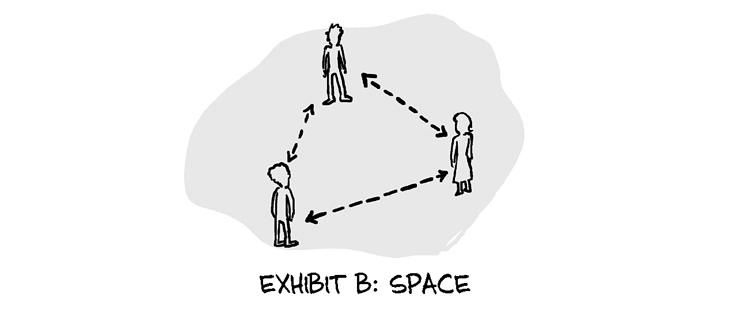
Exhibit B: space
This is a strange and counterintuitive view of space, especially since we have never met the concept of non-space. But strangeness has never been an obstacle for physics, so do not reject this possibility.
What space do we have?
Which of the above ideas about space is correct? Does space look like an endless void waiting to be filled? Or does it exist only in the context of matter?
It turns out that science is quite confident that space is not described by any of them. Space is clearly not emptiness, and obviously not a simple relationship between particles of matter. We know this because we have observed the behavior of space that does not fit into any of these ideas. We watched as space bends, ripples and expands.
At this point, your brain must say: "Chtaaaaaaaa? .."
If you were not distracted from reading, you should have been surprised by phrases such as "curvature of space" and "expansion of space." What can they mean? What is the point? If space is an idea, it cannot bend or expand, as it is impossible to chop it into cubes and fry with coriander (except in California, where you can do anything you want with coriander). If space is our ruler measuring the location of things, how can we measure the curvature or expansion of space?
Great questions! The reason why the idea of the curvature of space is confusing is that most of us are growing with the idea of space as an invisible backdrop against which everything happens. Perhaps you see space as a theater stage, mentioned earlier, with hard wooden planks as the floor and with hard walls on the sides. And, perhaps, you imagine that nothing in the Universe is capable of bending this scene, since this abstract construction is not part of the Universe, but is what contains the Universe.

- In my opinion, straight
Unfortunately, your presentation is wrong. To understand the meaning of the general theory of relativity and reflect on modern theories of space, you need to part with the idea of space as an abstract scene and accept its physical essence. You need to imagine that space has properties and behavior, and that it reacts to the matter of the Universe. It can pinch, squeeze, and even fill with coriander.
By this time, your brain should already give alarms related to the meaninglessness of what is happening: “What the # @ # $?!?!” This is understandable. But hold on because real madness is still ahead. By the end of the narrative, your alarms will be exhausted. But we need to carefully disclose these concepts in order to understand the ideas and appreciate the truly strange and basic mysteries of space that remain unsolved.
Space jelly - and you swim in it
How can space be a physical object, able to ripple or bend, and what does it mean?
This means that instead of being something like an empty room, the space is more like a huge piece of thick jelly. Usually objects can move in jelly without problems, as we can move in a room filled with air, without noticing air particles. But under certain conditions, this jelly can bend, changing the process of passing objects through it. It can also shrink and go in waves, changing the shape of things inside it.
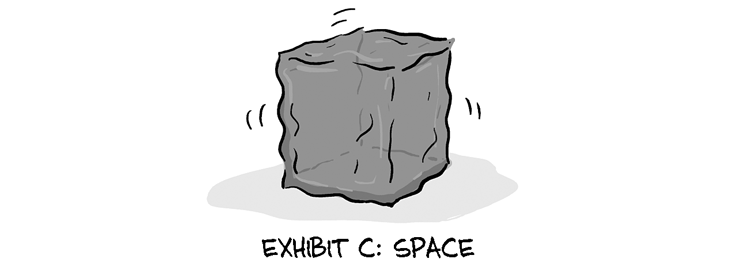
Exhibit B: space
This jelly (let's call it “spatial jelly”) will not be an ideal analogy to the nature of space (jelly exists in space, but we don’t know if space exists inside something else), but it will help you imagine that the space in which you are now, not necessarily fixed and abstract. You are in a certain environment, and this environment can stretch or shake or be distorted so that you may not feel it.
Perhaps a wave of space has just passed through you. Or you are now stretching in a strange direction, but you do not know. Until recently, we did not even notice that jelly in general somehow behaves, except that it is simply in its place and does not go anywhere, why we confused it with emptiness.
So what can this spatial jelly do? It turns out a lot of strange things.
First, the space can expand. Let's think carefully about what the expansion of space means. It means that objects move away from each other, while not moving with respect to the jelly. In our analogy, imagine that you are in jelly, and suddenly the jelly begins to grow and expand. If you are sitting opposite another person, this person is now farther from you, despite the fact that you both did not move relative to the jelly.
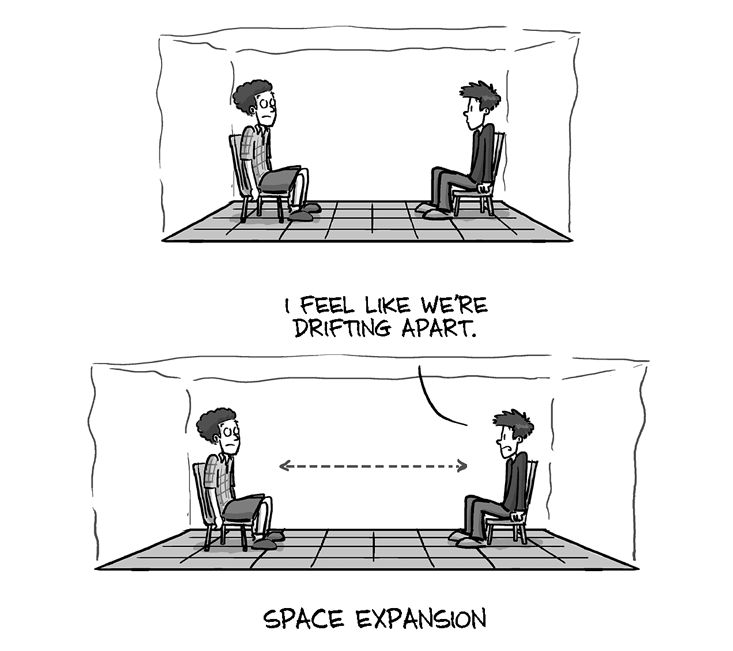
- I think we are moving away from each other.
How do we know that jelly has expanded? Will the ruler with which we measure jelly expand? The space between the atoms of the ruler would expand and stretch them to the sides. If the ruler was made from a very soft toffee, it would have expanded. But if your ruler is solid, all its atoms cling tightly to each other (using electromagnetic forces), and the ruler remains the same length, thanks to which you notice the appearance of additional space.
And we know about the expansion of space, because we see its expansion - this is how dark energy was discovered. We know that in the early Universe, space expanded at shocking speeds, and that such expansion is occurring today.

We also know that space can bend. Our jelly can be squeezed and deformed like a toffee. We know this from Einstein’s general theory of relativity, where it is described that gravity is the curvature of space. When an object has mass, it causes the surrounding space to be distorted and change shape.
When space changes shape, objects no longer move through it as you would imagine. Instead of moving in a straight line, a baseball passing through a pile of crooked jelly will twist with it. If the jelly is heavily twisted by something heavy, like a bowling ball, the baseball can even begin to move around it - just like the moon moves around the earth, or the earth around the sun.
This we can observe with the naked eye! For example, light distorts its path, passing close to massive objects, for example, our Sun or giant lumps of dark matter. If gravity were simply a force acting between objects with a mass, it would not be able to attract photons that do not have mass. The only way to explain the curvature of the path of light is the curvature of space itself.
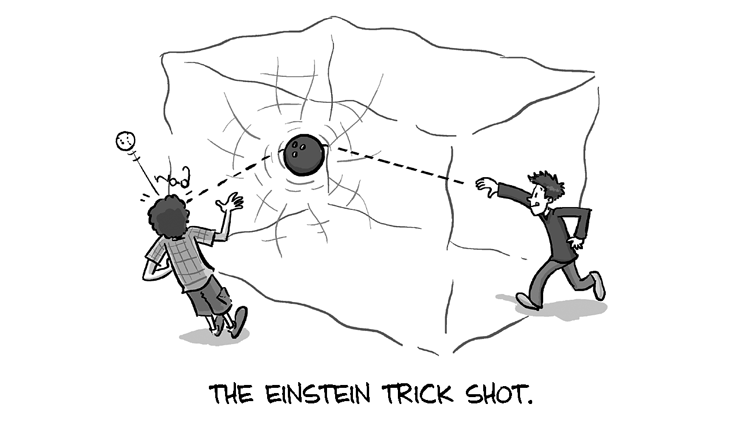
Tricky throw in Einstein
Finally, we know that space can go in waves. This is not so strange, given that we know that space can stretch and bend. It is interesting that the curvature and stretching can spread through the jelly - and this is called a gravitational wave. If you make a sudden curvature of space, it will spread outward as a sound wave or as a wave in a liquid. Such behavior can occur only if space has a certain physical nature, and it is not a simple abstract concept of pure emptiness.
We know that these waves are real because the GRT predicts them, and that we actually registered them. Somewhere in the Universe, two black holes revolved frantically in the arms of each other, and thus caused huge disturbances in space that spread outward. Using very sensitive equipment, we discovered these waves here on Earth.
These waves can be thought of as waves of expanding and contracting space. With the passage of such a wave space is compressed in one direction and expands in another.

Strange behavior, which is capable of space: expand, bend, worry, walk the wheel
Well, is this really the case? Are you sure?
No matter how crazy the idea is that space is an object, and not just an emptiness, this is what the Universe informs us through our perception. Our experimental observations clearly show that the distance between objects in space is not measured on an invisible abstract backdrop, but depends on the properties of the spatial jelly in which we all live, eat cookies and cut cilantro.
But if the idea of space, as a dynamic object with physical properties, can explain such phenomena as expansion and curvature of space, it leads us to new questions as a result.
For example, you may be tempted to say that what we called space must now be called physical jelly (“fizle”), but this jelly must be in something that now we can again call space. It would be very tricky, but as far as we know (and we know little), jelly does not have to be in something else. When the jelly is bent and distorted, this distortion changes the interaction of its parts - it is not a distortion of the jelly in relation to some larger room, which it fills.
But just because our spatial jelly does not have to be inside something else, does not mean that it is not inside something else. Perhaps what we call space is inside a larger “superspace.” It is possible that this superspace looks like an endless void - but we do not know.
Is it possible that in some parts of the universe there is no space? In other words, if space is jelly, is it possible that there is also the absence of jelly, non-jelly? The meaning of these concepts is not entirely clear, since all our physical laws imply the existence of space - so what laws could work outside of space? We do not know.
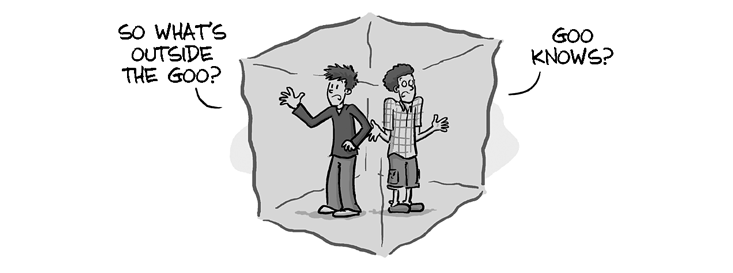
“So what's the jelly outside?”
- Unfortunately, it is not known.
A new idea of space as an object has appeared recently, and we are at the very beginning of the understanding of what space is. In a sense, we are still bound by our intuitive concepts. These concepts worked well when early men and women hunted and collected prehistoric cilantro, but we need to break free from the shackles of these concepts and understand that space is not at all like the way we imagined it.
Directly about curved space
If your brain still does not hurt from all these jelly concepts of space distortion, here is another mystery: the space is flat or bent (and if bent, then which way?)

The questions are insane, but they can be easily asked by adopting the idea of a pliable space. If space can bend around objects with mass, can it have a total curvature? It's like asking if our jelly is flat: you know that it can be deformed by clicking on a point, but does it generally sink? Or is it perfectly straight? You can ask the same questions about space.

Answers to these questions will seriously affect our understanding of the universe. For example, if the space is flat, it means that traveling in one direction, you will simply continue to move, perhaps infinitely.
But if space is curved, then other interesting things can happen. If the curvature of space is positive, then, traveling in one direction, you will make a loop and return to the same place on the other side! This is useful information if you, for example, do not like being sneaked up behind you.

The longest draw in the universe
Explaining the idea of a curved space is quite difficult, because our brains are not well adapted to visualize such concepts. And why would he need it? Most of our everyday experience (avoiding predators or finding car keys) deals with a three-dimensional world that looks fixed (although if we were attacked by aliens who can change the curvature of space, I hope that we would cope with this).
What would curvature mean for space? One of the ways to visualize is to pretend that we live in a two-dimensional world, caught on a piece of paper. This means that we can only move in two directions. If this leaf on which we live, lies exactly, we can say that our space is flat.

But if for some reason it is curved, we say that space is curved.

And paper can be curved in two ways. It can be curved in one direction (positive curvature), or different, like a saddle or Prings chips (this will be a negative curvature, or a violation of the diet).
And that's what's great: if we find that the space is flat everywhere, it will mean that a piece of paper (space) can last forever. But if we find that the space has a curvature of positive, then there is only one form that has positive curvature everywhere: the sphere. Or, technically speaking, a spheroid (for example, a potato). This is one way that our universe can become self-contained. We can all live in the three-dimensional equivalent of potatoes, which means that regardless of the chosen direction of movement, you will eventually return.

In this case, it turns out that we have the answer to a similar question - the space, apparently, is “rather flat”, that is, flat with an error of 0.4%. Scientists have calculated through two very different methods that the curvature of space (at least, of what we see) is almost zero.
What are these ways? One of them is the measurement of triangles. Curvature has an interesting property - triangles in a curved space do not obey the same rules as triangles in a flat space. Let us return to our analogy with a sheet of paper. A triangle drawn on a flat sheet will be different from a triangle drawn on a curved surface.

Scientists have conducted an experiment equivalent to measuring triangles in three-dimensional space, studying the spatial relationship captured in the image of the early Universe of its different points. They found that the measured triangles they correspond to a flat space.
Another way of telling us that space is flat is to study what leads to the curvature of space: energy in the Universe. According to GR, in the Universe there is a certain amount of energy (more precisely, energy density), forcing space to bend in one of the directions. It turns out that the value of the energy density, which we can measure in our Universe, just corresponds to the fact that space is not bent at all (with an error of 0.4%).
Some of you may be disappointed that we do not live in a cool three-dimensional potato tuber, which bends towards itself, if we fly in one direction. Of course, who has not dreamed of cutting circles across the universe on a rocket motorcycle in the style of Yvel of Knivela ? But instead of getting upset about the boring plane of the universe, you might be interested. Why? Because as far as we know, the flat essence of our Universe is a gigantic coincidence of cosmic scales.
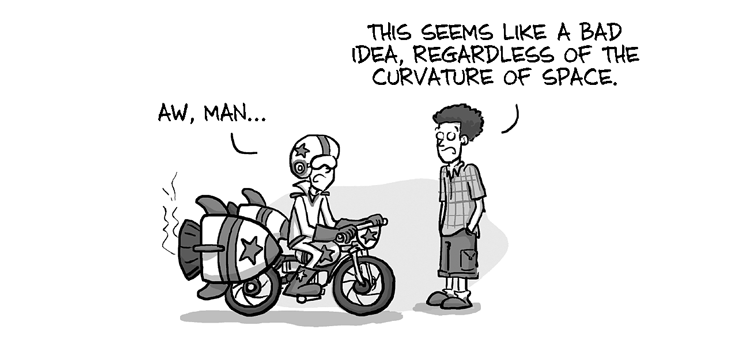
- In my opinion, this is a bad idea, regardless of the curvature of space
- Well bliin ...
Think about it. The whole mass and energy of the Universe gives curvature to space (remember that mass and energy distort space), and if we had even a little more mass and energy than now, space would be curved in one direction. And if we had them a little less, then the space would be curved in the other direction. But we, apparently, have just enough energy to make the space perfectly flat. The exact amount of matter needed for no curvature is five hydrogen atoms per cubic meter of space. If we had 6 or 4 atoms of hydrogen, our entire Universe would have been completely different (more curved and interesting, but different).
Next - weird. Since the curvature of space affects the movement of matter, and matter affects the curvature of space, there are feedback effects. If in the early days of the Universe, matter turned out to be at least a little more or not enough, and we would not come to this critical density of matter necessary for space to be flat, then everything would result in moving away from the flat state even further. In order for space to be flat now, it is necessary that it be extremely flat in the early Universe, or that something else would hold it in a flat state.
This is one of the greatest mysteries of space. We not only do not know what space is, we still do not know why it is what it is.
Space shape
Space curvature is not the only topic on which we have questions related to the nature of space. Once you accept that space is not an infinite void, but perhaps an infinite physical entity with properties, you may have many strange questions about this. For example - what is the size and shape of the space?
The size and shape of the space tells us what the volume of the existing space is and how it relates to itself. You may decide that since the space is flat and does not have the shape of a potato or a saddle (or a potato in a saddle), the idea of the size and shape of the space does not make sense. After all, if the space is flat, it means that it continues indefinitely, right? Not necessary!
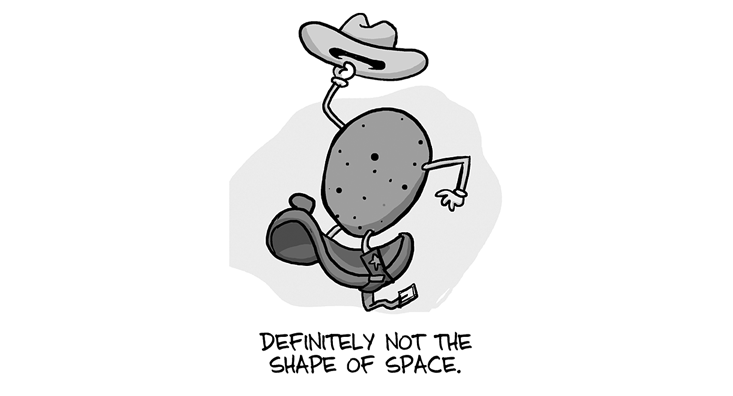
This clearly does not correspond to the shape of the space.
The space can be flat and infinite. Or it may be flat and have an edge. Or, more strangely, it can be flat and still lock itself on.
How can space have an edge? In principle, there are no reasons prohibiting a space from having an edge, even if it is flat. For example, a disk is a flat two-dimensional surface with a smooth continuous edge. Probably, the three-dimensional space also has a border due to its strange geometric properties on the edge.
Even more interesting is the possibility that the space can be flat and still close to itself. It will be like one of those video games like Asteroids or Pac-Man, where you, walking over the edge of the screen, simply appear on the other side. Space can somehow connect with itself. For example, wormholes are theoretically predicted by GR. In the wormhole, two different remote points of space can be connected to each other. What if the edges of space are connected to each other in the same way? We don't know that.
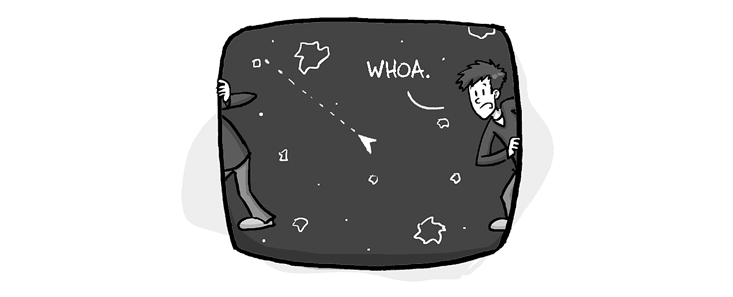
Quantum space
Finally, you can ask whether the space consists of tiny discrete pieces, like pixels on the screen body, or is it infinitely smooth, such that between two points there are infinitely many positions in which you can be?
The ancient scientists could not imagine that the air consists of tiny discrete molecules. The air seems continuous. It fills any volume and has interesting dynamic properties (wind and weather). But we know that everything that we like about the air (as it gently touches the cheek in the form of a cool summer breeze or as it does not allow us to suffocate), is actually due to the combined behavior of billions of individual molecules and is not a property of the molecules themselves.
The variant with a smooth space seems to us more meaningful. After all, it seems to us that we move in space smoothly and continuously. We do not jump from pixel to pixel, twitching like a video game character moving across the screen.
Or jump?

- Run! This is a pie chart!
Given our current understanding of the universe, it would be more surprising if space was infinitely smooth. After all, we know that everything else is quantized. Matter is quantized, energy is quantized, interactions are quantized, cookies of girls scouts are quantized.Moreover, quantum physics assumes the existence of a minimum meaningful length, 10 -35 m. So, from the point of view of quantum mechanics, it would be natural if space was quantized. But we do not know.
But the fact that we do not know this did not stop the physicists from insane assumptions! If space is quantized, it means that when we move, we actually jump from one small place to another. From this point of view, space is a network of connected nodes, such as a metro station. Each node is a location, and the connections between them represent the relationship between locations (which one is next to which). This is different from the idea that space is simply a relationship between parts of matter, since these nodes can be empty and still exist.
Interestingly, these nodes do not have to be inside a large space or structure. They may just exist. In this case, what we call space will be just a set of relationships between nodes, and all particles of the Universe will be just properties of this space, and not elements that are in it. For example, they can be the modes of vibration of these nodes.
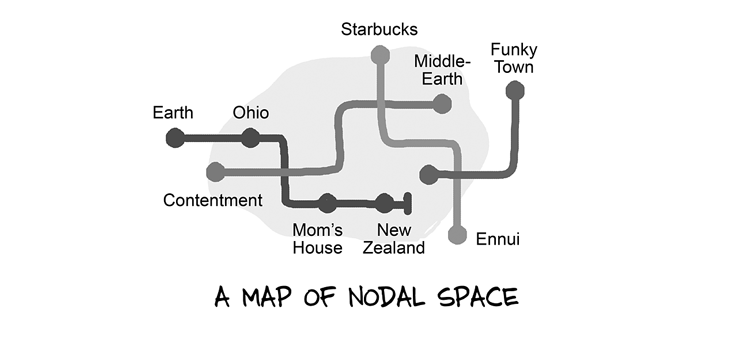
This is not as far-fetched as it seems. Modern particle theory is based on quantum fields that fill the entire space. A field means that there is a number, or a value, associated with each point in space. From this point of view, the particles are just the excited states of these fields. So we are close to such a theory.
By the way, physicists love such ideas, when something that seems fundamental to us (for example, space) comes from something deeper. This gives them the feeling of glancing behind the curtain and discovering a deeper level of reality. Some even suspect that the interrelationship of space nodes is formed by the entanglement of particles, but these are mathematical fantasies of a handful of theorists who drunk coffee.
Mysteries of space
If you have read this far and either understood everything or turned off your anxiety with nonsense so that it does not distract you, then we can without hesitation explore the craziest theory of space (yeah, even crazier).
If space is a physical object, not a backdrop or a construction, and it possesses such dynamic properties as distortions and waves, and is probably created from quantum pieces, then you should think: what else can space do?
Perhaps he, like air, there are different states and phases. It is possible that under extreme conditions it can be structured in a very unexpected way or exhibit unexpected properties, just as air behaves differently, depending on whether it is in a liquid, gaseous, or solid form. Perhaps the space we are familiar with, which we gladly occupy, is just one rare type of space, and there are other types of spaces in the Universe that are just waiting for us to understand how to create and work with them.

The most interesting tool that may come in handy for us in the search for an answer to this question is that space is distorted by mass and energy. To understand what space is and what it is capable of, it is best to carefully study its extreme states, where huge masses compress and stretch it: black holes. If we could explore the neighborhood of black holes, we could see the space cut and shredded so that our anxiety of nonsense just explodes.
And what is most interesting, we are already very close to the possibility of probing extreme deformations of space. Because, if earlier we were deaf to the ripples of gravitational waves moving through the Universe, now we have the opportunity to listen to cosmic events, stunning and disturbing the jelly of space. Perhaps in the near future we will understand more about the exact nature of space and answer these deep questions, literally surrounding us from all sides.
So, do not fall into prostration, and leave in your brain answer space.
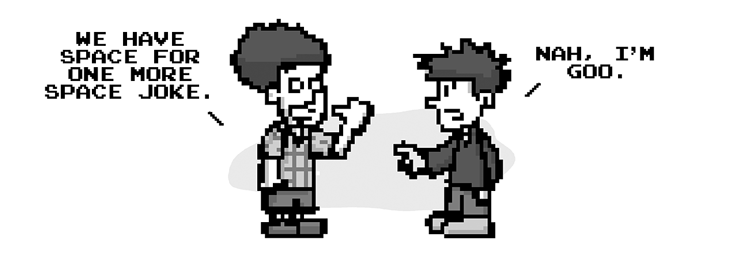
“We still have room for one space joke.”
- the disordered jelly ? No, that's enough for me.
«We Have No Idea: A Guide to the Unknown Universe» [ : ].
– , - Piled Higher and Deeper, .
– , , . .
Source: https://habr.com/ru/post/373701/
All Articles